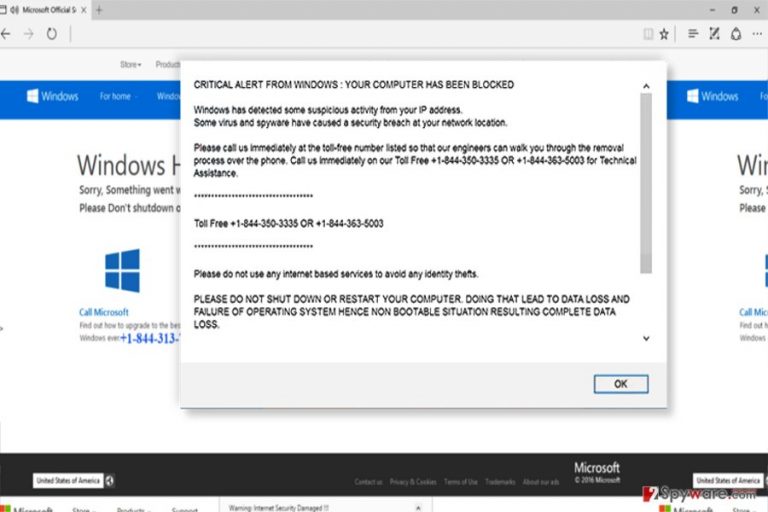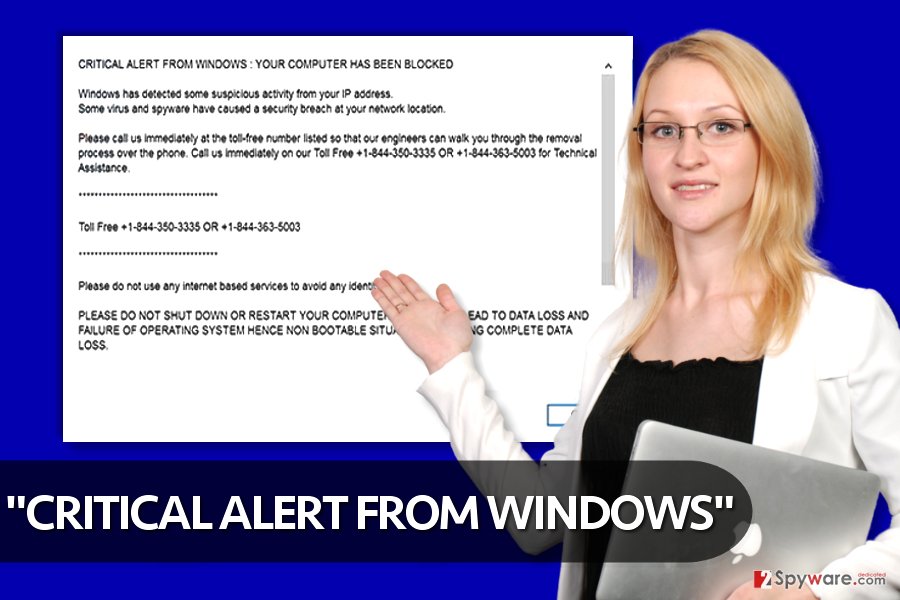“CRITICAL ALERT FROM WINDOWS” fake pop-up (Virus Removal Guide) - Microsoft Support Scam
“CRITICAL ALERT FROM WINDOWS” fake pop-up Removal Guide
What is “CRITICAL ALERT FROM WINDOWS” fake pop-up?
Tech support scammers now use “CRITICAL ALERT FROM WINDOWS” fake pop-ups to scam people for money

“CRITICAL ALERT FROM WINDOWS” fake pop-up is a deceptive message that might appear on your screen after entering a phishing website[1]. Tech support scammers[2] control such websites and deliver misleading messages to scare unsuspecting and inexperienced computer users.
The false message “informs” the victim that the computer has been blocked because “Windows has detected some suspicious activity from your IP address.” The alert falsely claims that virus or spyware has caused a security breach at victim’s network location, which is absolute nonsense.
Traditionally, the alert urges the victim to call a number provided in order to get help from “engineers” that ostensibly can walk the victim through the malware removal process via phone. If you're looking for honest malware removal guides, we invite you to visit sites such as DieViren[3] instead.
You should never call these scammers because sooner or later they will ask you to provide remote access to your computer or buy some useless software pack to fix imaginary issues.
Keep in mind that such tech support scams are designed to convey sense or urgency, stating that bad things will happen if the victim won’t react immediately. Unfortunately, many victims get on the hook and call the scammers.
However, instead of calling scammers, remove “CRITICAL ALERT FROM WINDOWS” fake pop-up virus using anti-malware program. Our team suggests using FortectIntego.

Please reboot your PC into Safe Mode with Networking before trying to delete the tech support scam virus from the system.We highly suggest using “CRITICAL ALERT FROM WINDOWS” fake pop-up removal instructions that we added at the end of this post.
Distribution of malicious tech support scam viruses
Malicious tech support scam programs that deliver fake alerts usually sneak into target computers with the help of software bundling, Trojans, or illegal software. Please be careful and think twice before downloading suspicious items to your PC system.
We highly suggest choosing Custom or Advanced software installation settings when installing new software. These options allow you to decompose software packs, so you can get rid of unwanted additions and install only the preferred software instantly.
You can accidentally install a tech support scam malware that displays CRITICAL ALERT FROM WINDOWS pop-ups after opening a malicious email attachment, too. Please pay attention to details and make sure you know the sender before opening files or links sent to you.
“CRITICAL ALERT FROM WINDOWS” fake pop-up removal steps
You need to carry out certain instructions to completely remove CRITICAL ALERT FROM WINDOWS pop-up virus. We highly suggest that you use instructions we provided. You will need to restart your PC first and run it into Safe Mode with Networking.
This allows you to clean the system without any unexpected interruptions. In some cases, viruses attempt to block anti-spyware and anti-malware programs to avoid detection and removal. However, you can easily complete CRITICAL ALERT FROM WINDOWS fake pop-up removal this way:
Getting rid of “CRITICAL ALERT FROM WINDOWS” fake pop-up. Follow these steps
Manual removal using Safe Mode
Close the browser that displays the annoying pop-ups for you. Try to scan the system with anti-malware program. If it doesn't detect anything, reboot your computer using these instructions and perform another system scan. Remember that you must use an up-to-date version of anti-malware in order to detect the latest security threats.
Important! →
Manual removal guide might be too complicated for regular computer users. It requires advanced IT knowledge to be performed correctly (if vital system files are removed or damaged, it might result in full Windows compromise), and it also might take hours to complete. Therefore, we highly advise using the automatic method provided above instead.
Step 1. Access Safe Mode with Networking
Manual malware removal should be best performed in the Safe Mode environment.
Windows 7 / Vista / XP
- Click Start > Shutdown > Restart > OK.
- When your computer becomes active, start pressing F8 button (if that does not work, try F2, F12, Del, etc. – it all depends on your motherboard model) multiple times until you see the Advanced Boot Options window.
- Select Safe Mode with Networking from the list.

Windows 10 / Windows 8
- Right-click on Start button and select Settings.

- Scroll down to pick Update & Security.

- On the left side of the window, pick Recovery.
- Now scroll down to find Advanced Startup section.
- Click Restart now.

- Select Troubleshoot.

- Go to Advanced options.

- Select Startup Settings.

- Press Restart.
- Now press 5 or click 5) Enable Safe Mode with Networking.

Step 2. Shut down suspicious processes
Windows Task Manager is a useful tool that shows all the processes running in the background. If malware is running a process, you need to shut it down:
- Press Ctrl + Shift + Esc on your keyboard to open Windows Task Manager.
- Click on More details.

- Scroll down to Background processes section, and look for anything suspicious.
- Right-click and select Open file location.

- Go back to the process, right-click and pick End Task.

- Delete the contents of the malicious folder.
Step 3. Check program Startup
- Press Ctrl + Shift + Esc on your keyboard to open Windows Task Manager.
- Go to Startup tab.
- Right-click on the suspicious program and pick Disable.

Step 4. Delete virus files
Malware-related files can be found in various places within your computer. Here are instructions that could help you find them:
- Type in Disk Cleanup in Windows search and press Enter.

- Select the drive you want to clean (C: is your main drive by default and is likely to be the one that has malicious files in).
- Scroll through the Files to delete list and select the following:
Temporary Internet Files
Downloads
Recycle Bin
Temporary files - Pick Clean up system files.

- You can also look for other malicious files hidden in the following folders (type these entries in Windows Search and press Enter):
%AppData%
%LocalAppData%
%ProgramData%
%WinDir%
After you are finished, reboot the PC in normal mode.
Finally, you should always think about the protection of crypto-ransomwares. In order to protect your computer from “CRITICAL ALERT FROM WINDOWS” fake pop-up and other ransomwares, use a reputable anti-spyware, such as FortectIntego, SpyHunter 5Combo Cleaner or Malwarebytes
How to prevent from getting malware
Stream videos without limitations, no matter where you are
There are multiple parties that could find out almost anything about you by checking your online activity. While this is highly unlikely, advertisers and tech companies are constantly tracking you online. The first step to privacy should be a secure browser that focuses on tracker reduction to a minimum.
Even if you employ a secure browser, you will not be able to access websites that are restricted due to local government laws or other reasons. In other words, you may not be able to stream Disney+ or US-based Netflix in some countries. To bypass these restrictions, you can employ a powerful Private Internet Access VPN, which provides dedicated servers for torrenting and streaming, not slowing you down in the process.
Data backups are important – recover your lost files
Ransomware is one of the biggest threats to personal data. Once it is executed on a machine, it launches a sophisticated encryption algorithm that locks all your files, although it does not destroy them. The most common misconception is that anti-malware software can return files to their previous states. This is not true, however, and data remains locked after the malicious payload is deleted.
While regular data backups are the only secure method to recover your files after a ransomware attack, tools such as Data Recovery Pro can also be effective and restore at least some of your lost data.
- ^ How to recognize phishing email messages, links, or phone calls. Microsoft. Safety & Security Center.
- ^ Avoiding technical support scams. Microsoft. Safety & Security Center.
- ^ DieViren.. DieViren. Malware Removal Guides, IT Security News.
